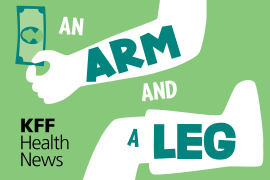WHO Releases Guidelines for Use of Antiretroviral Drugs to Treat HIV Infection in Developing Countries
The World Health Organization yesterday issued guidelines for the treatment of HIV in developing nations and included 12 antiretroviral drugs for that indication on its Essential Medicines List, a move that suggests "the debate over whether the world's poorest AIDS patients are ready for triple [drug] therapy has moved from rhetoric to practical planning," the Washington Post reports. The guidelines are basically a "short instruction manual" for health care providers in the developing world that recommends when to offer antiretroviral treatment to a patient, which drug combinations to try first, how to determine when a drug regimen is not working and how to amend drug regimens so that they work better. Although the recommendations outline a standard of treatment "very close to that in the United States," they also include "a few concessions to the harsh realities of medical care" in the developing world, the Post reports. For example, the guidelines suggest initiating antiretroviral treatment when CD4+ T cell counts fall below 200 per cubic millimeter, a level lower than that commonly used in the United States and other developed nations. In addition, the guidelines suggest that antiretroviral therapy can be started or altered based on a patient's clinical condition in situations where laboratory tests are not available (Brown, Washington Post, 4/23).
Antiretroviral Treatment Endorsed
The WHO Essential Medicines List is updated every two years and identifies drugs that the organization views as essential for disease treatment. The list is meant to "encourage" governments to make such treatments more widely available. Nevirapine and zidovudine were previously included on the list for reducing the risk of vertical HIV transmission, but the updated list also recommends that the drugs be used for treatment of HIV in adults and children. The list also includes 10 other antiretroviral medicines: abacavir, didanosine, efavirenz, indinavir, lamivudine, lopinavir, nelfinavir, ritonavir (low-dose), saquinavir and stavudine. WHO stated that the decision to include the drugs on the list of essential medicines was based on "a careful analysis of current evidence of antiretroviral efficacy in developing countries, which shows that these medicines can be used effectively and safely in poor settings" (WHO release, 4/22). In its guidelines, WHO recommended the use of triple-drug antiretroviral therapy and listed several drug combinations that can be used in such regimens. One such combination consists of a pill that includes both zidovudine and lamivudine, along with a third drug, such as efavirenz, nevirapine or abacavir. Outlining which drugs should be used in combination therapy "is a way to avoid all the waste and confusion and tendency to create resistance that exists in all the weird combinations that people came up with before," Dr. Jonathan Quick, WHO's director of Essential Drugs and Medicines Policy, said. Quick added that recommending certain drug combinations also encourages generic drug makers to put three drugs in one pill, which simplifies treatment regimens. But Dr. Harvey Bale, director of the International Federation of Pharmaceutical Manufacturers Associations, said that although large pharmaceutical manufacturers do not oppose the inclusion of patented drugs on the essential medicines list, combining three drugs into one pill is difficult and any such combinations must be "thoroughly tested." The
New York Times reports that large drug makers do not produce such combination pills because the patents to the drugs are often held by several different companies (McNeil, New York Times, 4/23). WHO hopes that ultimately, three million people in the developing world will be on
triple-drug antiretroviral therapy by 2005 (Washington Post, 4/23).
Silencing Critics
The New York Times reports that the WHO guidelines aim to "silence several sets of critics: drug industry executives who have argued that triple [drug] therapy is too complex and dangerous for poor, illiterate patients; AIDS skeptics like President Thabo Mbeki of South Africa who argue that the drugs don't work or are toxic; and experts who confuse public health doctors in poor countries by overwhelming them with competing drug combinations." Carmen Perez, pharmaceutical director for Doctors Without Borders, called the recommendations a "very good victory." When coupled with WHO's recommendations of quality manufacturers released last month, the guidelines provide countries with "the three bits of information they need -- the names of the drugs, the quality assurance and the treatment guidelines," she said (New York Times, 4/23). UNAIDS Executive Director Peter Piot added, "The antiretroviral treatment guidelines developed by WHO will greatly assist government and national AIDS programs in providing people living with HIV/AIDS with greater access to these life-saving medicines" (WHO release, 4/22). The guidelines are timed to coincide with the first round of grants to be issued tomorrow by the Global Fund to Fight AIDS, Tuberculosis and Malaria (see story 2). Officials hope that the recommendations will be used by countries that receive money from the fund (Zimmerman, Wall Street Journal, 4/23). A copy of the guidelines can be viewed online. The Essential Medicines List can also be viewed online.






